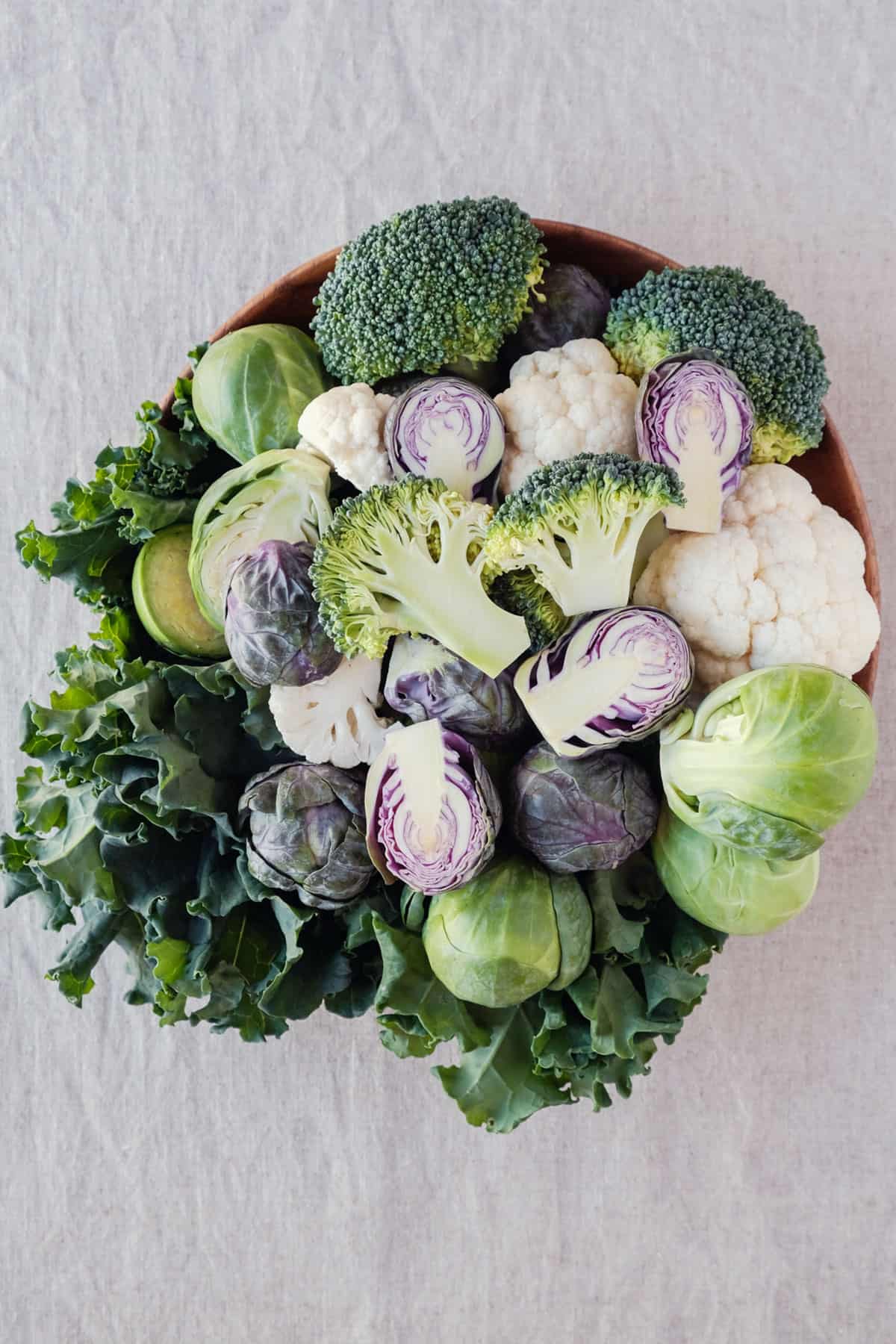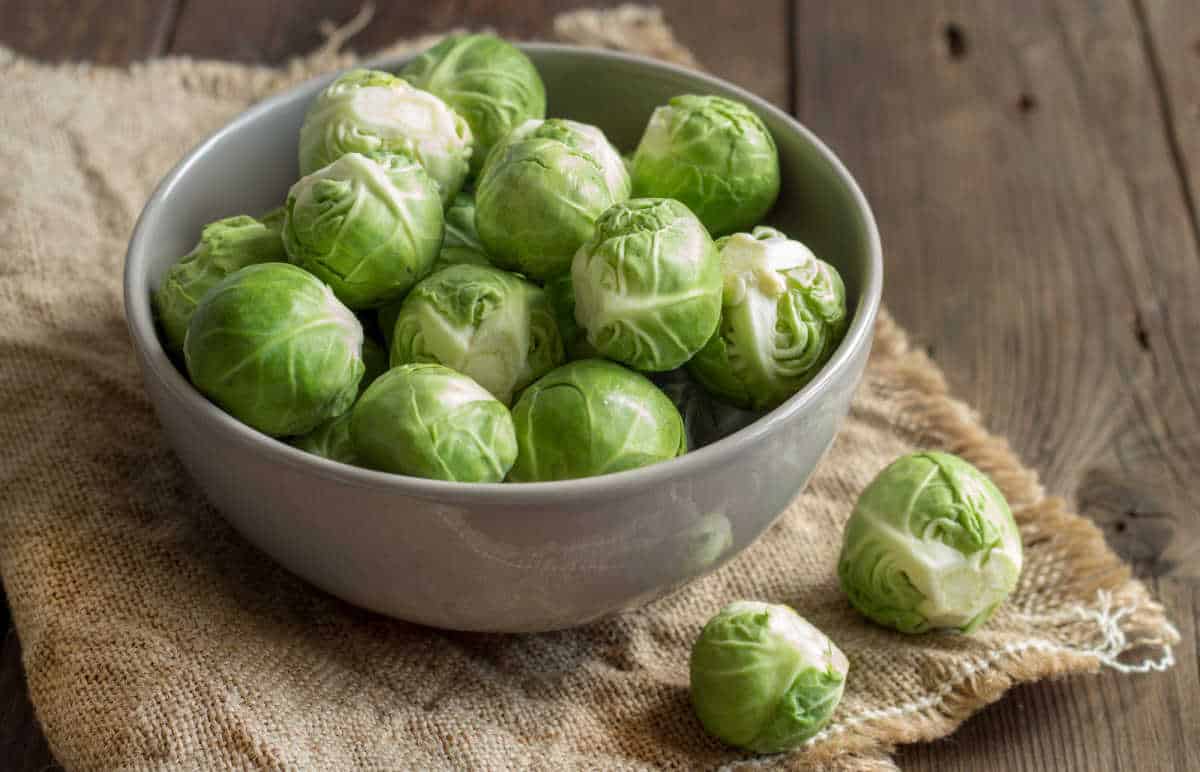Wondering which vegetables are cruciferous and why we should be eating more of them? Read on to find out all about cruciferous vegetables with a list, info, recipes and more.

I'm sure you've heard of cruciferous vegetables. Usually when someone says they're trying to eat more of them!
But you might be wondering which vegetables are part of this family? Scroll down for a list of cruciferous vegetables.
Maybe you're also wondering what makes a vegetable cruciferous or why we should eat more of them? Then read on for that too!
Be sure to also check out this list of List of Vegetables A-Z and Green Vegetables.
Jump to:
What are cruciferous vegetables?
Cruciferous vegetables are part of the cabbage family (Cruciferae) which contains the Brassica genus of plants.
They are rich in nutrients, vitamins, fiber, and minerals.
They're nutritional powerhouses that have more essential vitamins and nutrients than pretty much any other fruit or vegetable, calorie-for-calorie!
Cruciferous vegetables also contain glucosinolates, which are sulfur-containing chemicals. They cause the slightly bitter flavor and strong aroma in these veggies (think brussels sprouts!)
You'll probably have heard a lot about cruciferous vegetables. That's due to the many studies where cruciferous vegetables have been looked at as having the potential to reduce the risk of cancer.
They're also all-around nutritious and healthy vegetables that are perfect to make up a big part of a healthy diet.
And they taste great too!
What are the benefits of cruciferous vegetables?
Crucifers are rich in nutrients, including minerals and vitamins C, E, and K, folate, several carotenoids (beta-carotene, lutein, zeaxanthin).
These vegetables contain natural compounds that may be helpful for fighting cancer.
Crucifers are non-starchy and a good source of fiber.
They contain phytonutrients and antioxidants.
They have vitamin C, which acts as an antioxidant, to support the immune system.
They're a range of tasty vegetables that can be enjoyed in many ways, from salads and stews, to roasted and sauteed.
Cruciferous veggies are great as part of a healthy diet.

Cruciferous meaning
Pronounced: kroo-SIF-uh-ruhs
Cruciferous denotes plants of the cabbage family (Cruciferae).
The name comes from the four-petal flowers on the plants, that resemble a cross (crucifer).
Cruciferous vegetable facts
Cruciferous vegetables developed glucosinolates through evolving in order to fight against attacks from insects. The pungent, bitter, sulfurous compounds help to repel predatory insects.
There are more than 100 different types of cruciferous veggies, including broccoli, cabbage, kale and cauliflower.
Cruciferous vegetables are also called Brassicas.
Brussels sprouts have 5 x more glucosinolates than cauliflower.
Crucifers are a great source of calcium, vitamin K, and magnesium, which your body needs to maintain bone health.
Cauliflower is usually white, but can also be found green (the strange fractal-shaped Romanesco Cauliflower), orange and purple! If you can find purple cauliflower, it has twice the antioxidants of white.
The healthiest way to cook crucifers is to steam or saute them. This light cooking means they keep twice as many antioxidants.
Broccolini (sprouting broccoli), the ones with the long, thin stems, have more phytonutrients than regular heads of broccoli.
There are discussions about if crucifers are okay for those with thyroid issues. Always check with your doctor.
Cruciferous vegetables list
Here is the list of veggies in the cruciferous family. Scroll down for more information about each of these crucifers!
Arugula
Bok choi
Broccoli
Broccolini
Brussels sprouts
Cabbage
Cauliflower
Collard Greens
Cress
Daikon
Horseradish
Kale
Kohlrabi
Mustard Greens
Mizuna
Pak Choy
Radishes
Rocket
Romanesco
Rutabaga
Spring Greens
Swede
Swiss Chard
Tatsoi
Turnips
Turnip Greens
Wasabi
Watercress

More information about popular crucifers
Here is some more info, tips, and recipes for a few common cruciferous vegetables.

Arugula
Also known as rocket or rocca, Arugula is a leafy cruciferous vegetable that is part of the Brassicaceae or mustard family. It is popular in salads and on pizza as it has a fresh peppery flavor.

Bok Choi
Also known as bok choy or pak choi, bok choi is an Asian leafy green vegetable and a type of Chinese cabbage. It is a member of the brassica or cruciferous family. The dark green leaves grows from small clusters of short pale white stems. Use it in salads, soups, stir-fries and fillings for spring rolls, dumplings and potstickers.

Broccoli
Tasty Broccoli is a brassica or cruciferous vegetable from the cabbage family. Its large flowering head, as well as the stalk and small leaves, are all edible.
The popular vegetable can be enjoyed in many dishes, from soups and stews to side dishes.
It has lots of heart-healthy polyphenols. Its cousins, including broccolini, Calabrese, purple sprouting broccoli, Tenderstem, and broccoli rabe, are also cruciferous.

Brussels Sprouts
Popular at Christmas, Brussels Sprouts are a nutritious cruciferous vegetable. They look like tiny cabbages and are edible buds that grow on a tall stalk.
They can taste very sulfurous and bitter if overcooked, so try roasted balsamic Brussels sprouts as a tasty side dish. Brussels Sprouts come top of the charts when it comes to cruciferous goodness.

Cabbage
Cabbages are leafy green cruciferous brassicas that come in a variety of shapes, sizes, and colors, including white, green, and red/purple. From pointed napa cabbage to wrinkled savoy cabbage, there are plenty of nutritious types to choose from.
It can be boiled, steamed, sauteed, and added to soups, stews, and curries. Savoy cabbages contain the most glucosinolate of all the cabbages.

Cauliflower
Full of knobbly white florets, Cauliflower is a cruciferous vegetable surrounded by large leaves. If you can get it with the leaves, you can eat them too. Just cook the leaves like kale - chopped and sauteed or added to soups or stews.
You can boil, roast, steam, or add cauliflower to dishes. Although still full of goodness, cauliflower has far fewer glucosinolates and polyphenols than brussels sprouts of broccoli.

Kale
Kale is a leafy green cruciferous vegetable. There are different varieties, such as curly kale with rounded leaves, or lacinto kale (dinosaur kale) with long dark leaves.
You can cook kale in many ways: steamed, boiled, sauteed or added to soups and stews. To eat it raw in salads, it's best to massage the leaves to make them less chewy!
Recipes
Now that you know which vegetables are cruciferous, you'll want to eat more of them. Here are lots of veggie and vegan recipes to make the most of the healthy veggies! Good for you and tasty too. Win-win.
Cruciferous Vegetables
Looking for more ways to enjoy cruciferous vegetables?
Check out these vegetarian and vegan recipes, all with crucifers.
Enjoy healthy cruciferous broccoli in this tasty salad, with herby dressing.
Blitz up your cruciferous kale and use it in these tasty muffins. Perfect for breakfast or a snack.
Cauliflower cheese is a comfort food classic. It's a tasty way to get more cauliflower into your diet.
This kale soup is really quick and easy, plus it tastes incredible and is full of nourishing greens.
Roast up the entire head of cauliflower (with garlic and paprika), then slice into thick 'steaks'. As tasty as it is pretty.
Roast up your brussels sprouts with a burst of balsamic flavor.
Roast up your cauliflower and whiz it into this flavor-packed soup recipe.
This low-calorie cabbage soup is full of nourishing vegetables.
Roast up your romanesco (broccoli cauliflower) and use it in this tasty and healthy salad.
This is a crazy one! Use kale in this bright green kale cake. The fun way to eat your crucifers.
These battered and baked cauliflower 'wings' are a tasty way to eat your veg!
Get lots of kale in your diet with this easy Crockpot stew.
Turmeric adds goodness, color, and taste to this delicious roasted cauliflower.
Roast up your swede / rutabaga for a healthy cruciferous side dish.
Finely shredded cabbage and carrots are delicious in this simple salad.
Collard greens make a tasty (and healthy!) alternative to wraps. Try them with quinoa and sweet potato in this tasty recipe.
Swede (rutabaga) is also tasty as an alternative to mashed potato.
You can also find out more about veggies with this Vegetables List or this 101 guide to Legumes. Be sure to also check out Find Vegetarian Recipes You'll Love.
You may also be interested in a list of the Best Lentil Recipes or the Best Bean Recipes.
Find out more about Broad Beans, Parsnips, or Leeks.
Be sure to also check out this list of Vegetables That Start with A, as well other lists with the rest of the alphabet.

























Liz
I love all cruciferous vegetables!! I think it's because I love crunchy veggies so much and cruciferous vegetables are usually crunchy!
Dannii
These are some of my favourite vegetables, so it was really interesting the learn more about them.
Tavo
What an informative article! I devoured it! I love cruciferous veggies, and I learned so much more! Also, having this great stock of recipes calling for it is super useful! I'll sure be coming to this post many times!
Kristen
Love some of these recipe ideas! I will definitely try a few. Thank you for sharing!